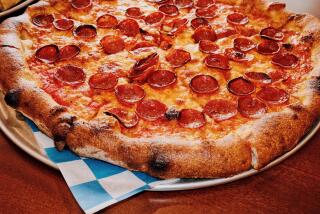Image-Building a Goal of Japan Emperor’s Visit
- Share via
Emperor Hirohito and Mickey Mouse, posing side-by-side at Disneyland: The image was perhaps the greatest achievement of the former priest-king’s first visit to the United States, in 1975.
Although some thought it undignified, the photograph conveyed just how much had changed in 30 years. The implacable enemy had become a friend, and the once awe-inspiring emperor had become the grandfatherly symbol of a country with a democratic constitution and a penchant for American pop culture.
Today, nearly two decades later, the late Hirohito’s son, Emperor Akihito, 60, and his wife, Empress Michiko, 59, arrive in Los Angeles. And while they will not be heading to the amusement park--Tokyo, after all, now has its own Disneyland--they again will be embarking on a task of image-building.
The goal this time is to let Los Angeles know that the distant islands facing its coast are home to a people who want to be friends as well as investors and trading partners.
The eighth city on the imperial couple’s 16-day American tour, Los Angeles has a more intense relationship with Japan than any other in the United States.
The city’s skyline was transformed by the flow of capital from Japan in the 1980s--decades after fear of bombers coming from the same direction helped create the city’s industrial might. Los Angeles is home to the largest concentration of Japanese Americans in the country, along with immigrants from China, Korea and other Asian countries who are still angry at Japan’s wartime aggression.
The mix of respect and resentment, which the politically powerless but symbolically potent emperor gets whenever he goes abroad, shows one thing still hasn’t changed since Hirohito’s time. Japan still is the only Asian country to have joined the upper echelon of Western industrial nations.
The institution of the emperor is inescapably linked with that achievement, and its problems. It was the emperor, taken from seclusion in Kyoto and presented to the nation in a Prussian-style military uniform, that a group of ambitious samurai used as the symbol of Japan’s 19th-Century drive to modernize.
It was the emperor that militarists used to rally their push to become a colonial power, and to attack the United States. It was the emperor that Gen. Douglas MacArthur used to represent postwar Japan’s transition to democracy. And it is the current emperor--a modest family man, amateur ichthyologist, and speaker of English--who Japan hopes will present a friendly face to the world today.
The imperial couple has focused on meeting “ordinary people” on their trip, including those from many ethnic backgrounds. They dined on American-style food--not French cuisine--at the White House, visited Thomas Jefferson’s home, called on MacArthur’s widow and were scheduled to spend the night at a private citizen’s home in Colorado.
In Los Angeles, they will have lunch with Mayor Richard Riordan and representatives of many ethnic communities of the city, have dinner with 650 local notables, view the Lincoln exhibition at the Huntington Library, see their old friends the Reagans, visit an exhibition on Japanese immigrants in Little Tokyo, and visit a Japanese American retirement home.
Martha Kawamura, an energetic 97-year-old resident of the home, said she finds the imperial couple appealing because of their public courtship back in the 1950s--on a tennis court. Kawamura, who is old enough to remember being in the 1906 San Francisco earthquake, recalled how her own first marriage was arranged, and proved less than satisfactory.
“It’s different when you fall in love first and then get married,” she said. “I’m glad their marriage was for love.”
Empress Michiko is a commoner, she notes, and the marriages of their two sons to American-educated commoners has also made the emperor and empress seem less distant.
On the other hand, 81-year-old Jack Shinagawa, born in Sacramento but raised until age 18 in Japan, feels no particular affection for the emperor and empress. He remembers when Emperor Hirohito’s train passed through his town--everyone had to line up and bow to it as it passed, never daring to look up.
“I thought it was kind of silly,” Shinagawa said. “To me, (their visit) is a small event. I’m an American citizen.”
Wherever the emperor goes, he is dogged by the past. The official transcribers of last week’s White House speeches made the same slip that many almost did, referring to Akihito as “Emperor Hirohito.”
Unlike Germany, Japan is widely seen as not facing up to its wartime past. In Washington and Atlanta, the emperor encountered protests by Chinese and Korean Americans of Japan’s lack of apology for wartime aggression.
On June 12, about 300 Chinese Americans, including survivors of the Nanking massacre, gathered in Monterey Park to protest the visit and demand war reparations and an apology. They plan to protest Tuesday near City Hall as well.
“What the Japanese did in Asia is . . . the forgotten holocaust,” said Lang Yun, a Beijing-born Los Angeles resident who is helping organize the protest.
The most significant conflict over history in this trip was the cancellation of the emperor’s planned stop at Pearl Harbor, which after objections by right-wingers in Japan was changed at the last minute to a visit to an Oahu cemetery.
Because of pressure from a tiny, sometimes-violent ultra-nationalist fringe in Japan, most politicians and academics still tiptoe around issues of the country’s war guilt and the emperor’s role.
On his American trip, the emperor has also been confronted over economic frictions caused by Japanese corporations and over Japanese politicians who have a habit of insulting American minorities.
When Hosea Williams, a veteran civil rights activist, met the emperor in Atlanta, press reports said that Williams told the emperor “in a loud voice” that when he visited Japan he found “Japanese people to be very disrespectful of black Americans.” The emperor reportedly thanked him for his “admirable question.”
In Washington, the 125th heir to a legendary 2,600 years of the unbroken imperial line found himself referred to by the Washington Post as “the emp” and “a fish nut.”
In Los Angeles, hotel maids and busboys plan to ask for his support in a labor dispute at the Japanese-owned New Otani Hotel.
“He’s kind of marching around being told by Americans that there are lots of things about Japan that Americans don’t like. . . . I guess that’s part of being a modern head of state,” said Fred Notehelfer, history professor and director of the Center for Japanese Studies at UCLA.
The emperor, he noted, was educated by an American Quaker tutor. “Maybe one of the reasons Americans are being more open is that he projects this more open quality so they say things to him they would never say to the old man.”
The emperor and empress are, of course, ordinary human beings with private lives. The emperor once admitted in a press conference that he occasionally even changed his children’s diapers. Notehelfer, who played at the same tennis club where the then-Crown Prince and Michiko Shoda met, recalled how “he was very pleasant and she was a very lively and full-of-life person.”
But they also remain the carefully managed symbols of Japan.
“One should watch with some interest how (the emperor and empress) are being presented,” Notehelfer said. “That’s what turning the emperor into a democratic symbol is about.”
More to Read
The biggest entertainment stories
Get our big stories about Hollywood, film, television, music, arts, culture and more right in your inbox as soon as they publish.
You may occasionally receive promotional content from the Los Angeles Times.










